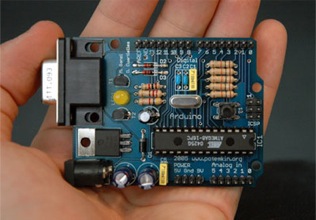Welcome to Shale
Shale (Shadows & Levers) receives input from the web camera and outputs data to a projector, which projects virtual objects (e.g. falling spheres) onto a whiteboard or blank wall. Affixed to the wall are mechanical/physical objects and the beam of a green laser pointer, which are seen by the web camera, and interpreted by digital image processing software within Shale. Shale then combines the web camera's input and correlates the locations of the virtual objects to create an interactive environment. Shale will also interact with the physical objects through use of a wireless transmitter. It will send signals to these physical objects when they interact with virtual objects, triggering movement (through motors), lights (through LEDs), or sounds (through speakers).About the Craft Technology Group
CU Craft Technology Group is a part of the Center for Lifelong Learning and Design at the University of Colorado specializing in the integration of computation and craft materials to produce mathematical or educational toys and activities for children. The group consists of a small number of faculty members and students working on the Boulder Campus of the University.Previously, CU Craft Technology collaborated with a team of undergraduate software engineers to develop a project entitled Laser Ball. This program created a combination of virtual and physical elements through the use of digital image recognition. Project Shale is an expansion upon this project, and will include wireless communication with the physical objects, in order to enable more advanced interactions such as movements, lights, and sound.
- Read the Shale Specification for a description of the platform.
- Want to give it a try? Check out the getting started page on the wiki.
- Post any questions you may have to the Shale Forums.
- Suggestions are always welcome. Tell us how you think we could improve Shale.
- What's next? If you are interested in helping with the development of Shale, email us to be added as a collaborator on the Shale docs.
Shale Libraries
Shale is built on top of Processing/Java, as long as you have the right webcam drivers you can run it on Mac or Windows. In order to get started you'll need a few things first...- Processing
- Java Runtime Environment
- WINVDIG (windows only)
- JMyron Processing Library
- + more help available on the wiki...
Shale+Arduino
The craft technology group's implementation of Shale uses Arduino microcontrollers coupled with 2.4ghz wireless Xbee modules to build the addressable mechanical objects seen in the demonstration videos. That's not to say you can't use any serially addressable hardware platform you wish, it's just we have sample code for these ;)
Photo by Nicholas Zambetti

Photo by Lady Ada
- Arduino Microcontrollers - the community that exists around building things with these is the best!
- Xbee's + Arduino Shield - Lady Ada has awesome examples for setting up wireless serial links with Xbee's
- Arduino + Motor Shield - this helps a bunch when hooking up motors!
- The Maker Shed store - a great resource for motors
- + more help available on the wiki...


 forums
forums downloads
downloads issues
issues source code
source code documentation
documentation contact
contact